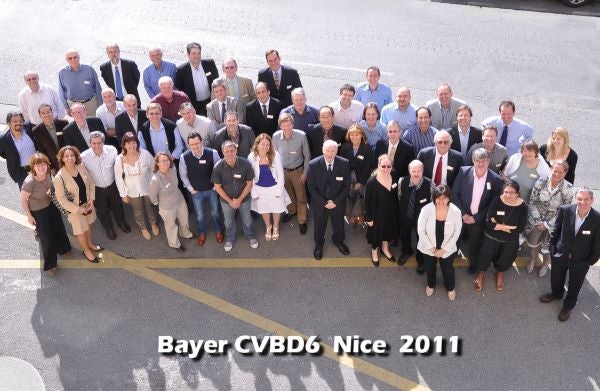6th CVBD Symposium
“EVOLUTION”
April 11-13, 2011, Nice, France

Participants of the 6th CVBD World Forum Symposium
Leading experts from around the world came together today to share their latest research findings at the 6th Companion Vector Borne Disease (CVBD) forum in Nice, France, and call for greater awareness of the dangers posed to animals and humans by these increasingly important diseases. “A number of the CVBDs cause real suffering and even death in dogs, and many represent a zoonotic risk. It’s vital that veterinarians and pet owners everywhere understand the seriousness of the threats posed, and take action to prevent transmission of these diseases” said Prof. Dwight Bowman of the College of Veterinary Medicine, Cornell University, USA.
“Data presented here highlight the underestimation and underreporting of serious diseases such as Tick-Borne Encephalitis (TBE), despite their potential to threaten the life of infected animals” according to Prof. Martin Pfeffer of the Bundeswehr Institute of Microbiology, Germany. “Like many of the CVBDs, TBE has spread beyond its traditional home and is being found across Europe and Asia, exposing previously unaffected populations to this serious disease. In light of the increasing geographical spread of diseases like TBE, veterinarians should ensure all dogs are protected from the threat of CVBD transmission and should consider even ‘exotic’ or ‘rare’ diseases when diagnosing sick animals.”
This theme was taken up by Prof. Luís Cardoso of the Department of Veterinary Sciences at the University of Trás-os-Montes e Alto Douro, Portugal, whose group reported the first cases of clinical babesiosis by Babesia microti-like piroplasm outside Spain. “This finding is important as this form of babesiosis is previously unknown in Portugal and we found not just two infected adults with a history of travel to endemic areas, but also infection in a puppy with no history of travel outside the country. This suggests that either the disease is capable of being transmitted from mother to pup or that there is now a reservoir of infection in Portugal.”
Further evidence of the changing face of CVBD management came from Dr. Filipe Dantas-Torres of the Department of Veterinary Public Health and Veterinary Medicine at the University of Bari, Italy, who presented data suggesting that the common Brown Dog tick (Rhicephalus sanguineus) has the potential to be a reservoir for leishmaniosis, a disease that can prove fatal to dogs and humans. Dr. Dantas-Torres explained “If our hypothesis is confirmed, we would in a next step investigate whether ticks could also transmit leishmaniosis to dogs which would dramatically increase the geographical reach of leishmaniosis. At current however, only sand flies are proven biological vectors of the Leishmania parasite.”
According to Prof. Domenico Otranto of the Faculty of Veterinary Medicine, Universitá degli Studi di Bari, Italy, “These findings reinforce the message that tick bite and sand fly prevention through a repellent parasiticide is a must for all dogs travelling to CVBD endemic areas. Not just because of the threat posed to the animal itself, but also to prevent the CVBD pathogens establishing in new, non-endemic areas and spreading via blood-sucking parasites and possibly also to the offspring of infected dogs.”
Many of the discoveries presented at this year’s meeting were made possible thanks to the evolving development in the molecular biology technology area. Prof. Robin Gasser of the Faculty of Veterinary Science, University of Melbourne, Australia, discussed the future role of the most advanced technologies, the ‘omics’ era (genomics, proteomics, lipidomics, etc.), in the diagnosis and control of CVBD. Prof. Gasser spoke of the revolutionary impact expected as these new technologies become more widely available, “We can expect to see these technologies change the face of CVBD management as they radically improve our understanding of parasite, vector and host relationships, epidemiology and ecology, ultimately leading to the design of radically new interventions and management strategies against these diseases.”
In this context, Dr. Xavier Roura of the Veterinarian Teaching Hospital at the College of Veterinary Medicine at the Universitat Autònoma de Barcelona, Spain, presented promising new applications of PCR diagnostics at the meeting and emphasized the value of these new techniques; “The advent of Real Time PCR means that it is now possible to track disease development though reliable quantitative results. Veterinarians need to be aware of these new advances in diagnostics that make identification of CVBDs more accessible and accurate and take action to ensure that they take advantage of their benefits to improve prognosis and treatment decisions.”
The CVBD World Forum is supported by Bayer Animal Health* as part of its ongoing commitment to advancing research into CVBDs worldwide. “We are committed to advancing the scientific understanding of CVBDs by bringing together the latest researchers from around the world in this unique forum – we are proud to have played our part in ensuring the next chapter in global CVDB management and prevention is written in 2011,” said Maria de Lourdes Mottier, Global Veterinary Services Manager, Bayer Animal Health.
A collection of scientific manuscripts that have been published open access in the course of the 6th International CVBD Symposium can be found here.
*now Elanco Animal Health
